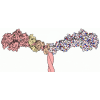+ データを開く
データを開く
- 基本情報
基本情報
| 登録情報 | データベース: PDB / ID: 7lsy | |||||||||||||||||||||
|---|---|---|---|---|---|---|---|---|---|---|---|---|---|---|---|---|---|---|---|---|---|---|
| タイトル | NHEJ Short-range synaptic complex | |||||||||||||||||||||
 要素 要素 |
| |||||||||||||||||||||
 キーワード キーワード | DNA BINDING PROTEIN/DNA / NHEJ / DNA BINDING PROTEIN / DNA BINDING PROTEIN-DNA complex | |||||||||||||||||||||
| 機能・相同性 |  機能・相同性情報 機能・相同性情報FHA domain binding / positive regulation of chromosome organization / positive regulation of ligase activity / DNA ligase IV complex / DNA ligase activity / Ku70:Ku80 complex / DN2 thymocyte differentiation / DNA ligase (ATP) / negative regulation of t-circle formation / T cell receptor V(D)J recombination ...FHA domain binding / positive regulation of chromosome organization / positive regulation of ligase activity / DNA ligase IV complex / DNA ligase activity / Ku70:Ku80 complex / DN2 thymocyte differentiation / DNA ligase (ATP) / negative regulation of t-circle formation / T cell receptor V(D)J recombination / DNA end binding / pro-B cell differentiation / small-subunit processome assembly / positive regulation of lymphocyte differentiation / DNA ligase (ATP) activity / DNA-dependent protein kinase complex / DNA-dependent protein kinase-DNA ligase 4 complex / immunoglobulin V(D)J recombination / nonhomologous end joining complex / nucleotide-excision repair, DNA gap filling / single strand break repair / regulation of smooth muscle cell proliferation / cellular response to X-ray / V(D)J recombination / nuclear telomere cap complex / double-strand break repair via classical nonhomologous end joining / isotype switching / Cytosolic sensors of pathogen-associated DNA / protein localization to site of double-strand break / IRF3-mediated induction of type I IFN / positive regulation of neurogenesis / recombinational repair / regulation of telomere maintenance / U3 snoRNA binding / protein localization to chromosome, telomeric region / DNA biosynthetic process / cellular response to lithium ion / cellular hyperosmotic salinity response / response to ionizing radiation / 2-LTR circle formation / telomeric DNA binding / hematopoietic stem cell proliferation / ligase activity / positive regulation of protein kinase activity / 付加脱離酵素(リアーゼ); 炭素-酸素リアーゼ類; その他の炭素-酸素リアーゼ / site of DNA damage / T cell differentiation / 5'-deoxyribose-5-phosphate lyase activity / somatic stem cell population maintenance / hematopoietic stem cell differentiation / response to X-ray / chromosome organization / ATP-dependent activity, acting on DNA / telomere maintenance via telomerase / SUMOylation of DNA damage response and repair proteins / condensed chromosome / DNA polymerase binding / neurogenesis / telomere maintenance / activation of innate immune response / DNA helicase activity / cyclin binding / cellular response to leukemia inhibitory factor / central nervous system development / B cell differentiation / stem cell proliferation / response to gamma radiation / cellular response to ionizing radiation / small-subunit processome / enzyme activator activity / Nonhomologous End-Joining (NHEJ) / cellular response to gamma radiation / protein-DNA complex / base-excision repair / double-strand break repair via nonhomologous end joining / 加水分解酵素; 酸無水物に作用; 酸無水物に作用・細胞または細胞小器官の運動に関与 / establishment of integrated proviral latency / fibrillar center / positive regulation of fibroblast proliferation / T cell differentiation in thymus / double-strand break repair / site of double-strand break / double-stranded DNA binding / neuron apoptotic process / fibroblast proliferation / scaffold protein binding / secretory granule lumen / DNA recombination / transcription regulator complex / in utero embryonic development / ficolin-1-rich granule lumen / negative regulation of neuron apoptotic process / damaged DNA binding / chromosome, telomeric region / cell population proliferation / transcription cis-regulatory region binding / ribonucleoprotein complex / innate immune response / cell division / negative regulation of DNA-templated transcription 類似検索 - 分子機能 | |||||||||||||||||||||
| 生物種 |  Homo sapiens (ヒト) Homo sapiens (ヒト) | |||||||||||||||||||||
| 手法 | 電子顕微鏡法 / 単粒子再構成法 / クライオ電子顕微鏡法 / 解像度: 8.4 Å | |||||||||||||||||||||
 データ登録者 データ登録者 | He, Y. / Chen, S. | |||||||||||||||||||||
| 資金援助 |  米国, 6件 米国, 6件
| |||||||||||||||||||||
 引用 引用 |  ジャーナル: Nature / 年: 2021 ジャーナル: Nature / 年: 2021タイトル: Structural basis of long-range to short-range synaptic transition in NHEJ. 著者: Siyu Chen / Linda Lee / Tasmin Naila / Susan Fishbain / Annie Wang / Alan E Tomkinson / Susan P Lees-Miller / Yuan He /   要旨: DNA double-strand breaks (DSBs) are a highly cytotoxic form of DNA damage and the incorrect repair of DSBs is linked to carcinogenesis. The conserved error-prone non-homologous end joining (NHEJ) ...DNA double-strand breaks (DSBs) are a highly cytotoxic form of DNA damage and the incorrect repair of DSBs is linked to carcinogenesis. The conserved error-prone non-homologous end joining (NHEJ) pathway has a key role in determining the effects of DSB-inducing agents that are used to treat cancer as well as the generation of the diversity in antibodies and T cell receptors. Here we applied single-particle cryo-electron microscopy to visualize two key DNA-protein complexes that are formed by human NHEJ factors. The Ku70/80 heterodimer (Ku), the catalytic subunit of the DNA-dependent protein kinase (DNA-PKcs), DNA ligase IV (LigIV), XRCC4 and XLF form a long-range synaptic complex, in which the DNA ends are held approximately 115 Å apart. Two DNA end-bound subcomplexes comprising Ku and DNA-PKcs are linked by interactions between the DNA-PKcs subunits and a scaffold comprising LigIV, XRCC4, XLF, XRCC4 and LigIV. The relative orientation of the DNA-PKcs molecules suggests a mechanism for autophosphorylation in trans, which leads to the dissociation of DNA-PKcs and the transition into the short-range synaptic complex. Within this complex, the Ku-bound DNA ends are aligned for processing and ligation by the XLF-anchored scaffold, and a single catalytic domain of LigIV is stably associated with a nick between the two Ku molecules, which suggests that the joining of both strands of a DSB involves both LigIV molecules. | |||||||||||||||||||||
| 履歴 |
|
- 構造の表示
構造の表示
| ムービー |
 ムービービューア ムービービューア |
|---|---|
| 構造ビューア | 分子:  Molmil Molmil Jmol/JSmol Jmol/JSmol |
- ダウンロードとリンク
ダウンロードとリンク
- ダウンロード
ダウンロード
| PDBx/mmCIF形式 |  7lsy.cif.gz 7lsy.cif.gz | 856.9 KB | 表示 |  PDBx/mmCIF形式 PDBx/mmCIF形式 |
|---|---|---|---|---|
| PDB形式 |  pdb7lsy.ent.gz pdb7lsy.ent.gz | 表示 |  PDB形式 PDB形式 | |
| PDBx/mmJSON形式 |  7lsy.json.gz 7lsy.json.gz | ツリー表示 |  PDBx/mmJSON形式 PDBx/mmJSON形式 | |
| その他 |  その他のダウンロード その他のダウンロード |
-検証レポート
| 文書・要旨 |  7lsy_validation.pdf.gz 7lsy_validation.pdf.gz | 953.8 KB | 表示 |  wwPDB検証レポート wwPDB検証レポート |
|---|---|---|---|---|
| 文書・詳細版 |  7lsy_full_validation.pdf.gz 7lsy_full_validation.pdf.gz | 1.1 MB | 表示 | |
| XML形式データ |  7lsy_validation.xml.gz 7lsy_validation.xml.gz | 137 KB | 表示 | |
| CIF形式データ |  7lsy_validation.cif.gz 7lsy_validation.cif.gz | 203.5 KB | 表示 | |
| アーカイブディレクトリ |  https://data.pdbj.org/pub/pdb/validation_reports/ls/7lsy https://data.pdbj.org/pub/pdb/validation_reports/ls/7lsy ftp://data.pdbj.org/pub/pdb/validation_reports/ls/7lsy ftp://data.pdbj.org/pub/pdb/validation_reports/ls/7lsy | HTTPS FTP |
-関連構造データ
- リンク
リンク
- 集合体
集合体
| 登録構造単位 | 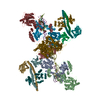
|
|---|---|
| 1 |
|
- 要素
要素
-X-ray repair cross-complementing protein ... , 2種, 4分子 AJBK
| #1: タンパク質 | 分子量: 68872.875 Da / 分子数: 2 / 由来タイプ: 組換発現 / 由来: (組換発現)  Homo sapiens (ヒト) / 遺伝子: XRCC6, G22P1 / 発現宿主: Homo sapiens (ヒト) / 遺伝子: XRCC6, G22P1 / 発現宿主:  unidentified baculovirus (ウイルス) unidentified baculovirus (ウイルス)参照: UniProt: P12956, 加水分解酵素; 酸無水物に作用; 酸無水物に作用・細胞または細胞小器官の運動に関与, 付加脱離酵素(リアーゼ); 炭素- ...参照: UniProt: P12956, 加水分解酵素; 酸無水物に作用; 酸無水物に作用・細胞または細胞小器官の運動に関与, 付加脱離酵素(リアーゼ); 炭素-酸素リアーゼ類; その他の炭素-酸素リアーゼ #2: タンパク質 | 分子量: 82812.438 Da / 分子数: 2 / 由来タイプ: 組換発現 / 由来: (組換発現)  Homo sapiens (ヒト) / 遺伝子: XRCC5, G22P2 / 発現宿主: Homo sapiens (ヒト) / 遺伝子: XRCC5, G22P2 / 発現宿主:  unidentified baculovirus (ウイルス) unidentified baculovirus (ウイルス)参照: UniProt: P13010, 加水分解酵素; 酸無水物に作用; 酸無水物に作用・細胞または細胞小器官の運動に関与 |
|---|
-DNA鎖 , 5種, 5分子 DEMNV
| #3: DNA鎖 | 分子量: 7936.151 Da / 分子数: 1 / 由来タイプ: 合成 / 由来: (合成)  Homo sapiens (ヒト) Homo sapiens (ヒト) |
|---|---|
| #4: DNA鎖 | 分子量: 4284.812 Da / 分子数: 1 / 由来タイプ: 合成 / 由来: (合成)  Homo sapiens (ヒト) Homo sapiens (ヒト) |
| #7: DNA鎖 | 分子量: 4271.830 Da / 分子数: 1 / 由来タイプ: 合成 / 由来: (合成)  Homo sapiens (ヒト) Homo sapiens (ヒト) |
| #8: DNA鎖 | 分子量: 7964.145 Da / 分子数: 1 / 由来タイプ: 合成 / 由来: (合成)  Homo sapiens (ヒト) Homo sapiens (ヒト) |
| #9: DNA鎖 | 分子量: 6185.046 Da / 分子数: 1 / 由来タイプ: 合成 / 由来: (合成)  Homo sapiens (ヒト) Homo sapiens (ヒト) |
-タンパク質 , 3種, 8分子 FGOPHIXY
| #5: タンパク質 | 分子量: 38337.703 Da / 分子数: 4 / 由来タイプ: 組換発現 / 由来: (組換発現)  Homo sapiens (ヒト) / 遺伝子: XRCC4 / 発現宿主: Homo sapiens (ヒト) / 遺伝子: XRCC4 / 発現宿主:  unidentified baculovirus (ウイルス) / 参照: UniProt: Q13426 unidentified baculovirus (ウイルス) / 参照: UniProt: Q13426#6: タンパク質 | 分子量: 33372.234 Da / 分子数: 2 / 由来タイプ: 組換発現 / 由来: (組換発現)  Homo sapiens (ヒト) / 遺伝子: NHEJ1, XLF / 発現宿主: Homo sapiens (ヒト) / 遺伝子: NHEJ1, XLF / 発現宿主:  #10: タンパク質 | 分子量: 104124.953 Da / 分子数: 2 / 由来タイプ: 組換発現 / 由来: (組換発現)  Homo sapiens (ヒト) / 遺伝子: LIG4 / 発現宿主: Homo sapiens (ヒト) / 遺伝子: LIG4 / 発現宿主:  unidentified baculovirus (ウイルス) / 参照: UniProt: P49917, DNA ligase (ATP) unidentified baculovirus (ウイルス) / 参照: UniProt: P49917, DNA ligase (ATP) |
|---|
-実験情報
-実験
| 実験 | 手法: 電子顕微鏡法 |
|---|---|
| EM実験 | 試料の集合状態: PARTICLE / 3次元再構成法: 単粒子再構成法 |
- 試料調製
試料調製
| 構成要素 | 名称: Short-range synaptic complex of NHEJ / タイプ: COMPLEX / Entity ID: all / 由来: MULTIPLE SOURCES | ||||||||||||||||||||||||||||||
|---|---|---|---|---|---|---|---|---|---|---|---|---|---|---|---|---|---|---|---|---|---|---|---|---|---|---|---|---|---|---|---|
| 分子量 | 値: 0.72 MDa / 実験値: NO | ||||||||||||||||||||||||||||||
| 緩衝液 | pH: 7.9 | ||||||||||||||||||||||||||||||
| 緩衝液成分 |
| ||||||||||||||||||||||||||||||
| 試料 | 包埋: NO / シャドウイング: NO / 染色: NO / 凍結: YES | ||||||||||||||||||||||||||||||
| 試料支持 | グリッドの材料: COPPER / グリッドのサイズ: 200 divisions/in. / グリッドのタイプ: Quantifoil R3.5/1 | ||||||||||||||||||||||||||||||
| 急速凍結 | 装置: FEI VITROBOT MARK IV / 凍結剤: ETHANE / 湿度: 100 % / 凍結前の試料温度: 277 K |
- 電子顕微鏡撮影
電子顕微鏡撮影
| 実験機器 |  モデル: Titan Krios / 画像提供: FEI Company |
|---|---|
| 顕微鏡 | モデル: FEI TITAN KRIOS |
| 電子銃 | 電子線源:  FIELD EMISSION GUN / 加速電圧: 300 kV / 照射モード: FLOOD BEAM FIELD EMISSION GUN / 加速電圧: 300 kV / 照射モード: FLOOD BEAM |
| 電子レンズ | モード: DARK FIELD / 倍率(公称値): 30000 X / 最大 デフォーカス(公称値): 4000 nm / 最小 デフォーカス(公称値): 1500 nm / Cs: 2.7 mm / C2レンズ絞り径: 100 µm / アライメント法: BASIC |
| 試料ホルダ | 凍結剤: NITROGEN 試料ホルダーモデル: FEI TITAN KRIOS AUTOGRID HOLDER |
| 撮影 | 平均露光時間: 0.0426 sec. / 電子線照射量: 46 e/Å2 / フィルム・検出器のモデル: GATAN K3 (6k x 4k) / 撮影したグリッド数: 2 / 実像数: 32723 |
| 画像スキャン | 横: 11520 / 縦: 8184 |
- 解析
解析
| EMソフトウェア |
| ||||||||||||||||||||||||||||||||||||||||||||||||||||
|---|---|---|---|---|---|---|---|---|---|---|---|---|---|---|---|---|---|---|---|---|---|---|---|---|---|---|---|---|---|---|---|---|---|---|---|---|---|---|---|---|---|---|---|---|---|---|---|---|---|---|---|---|---|
| CTF補正 | タイプ: NONE | ||||||||||||||||||||||||||||||||||||||||||||||||||||
| 粒子像の選択 | 選択した粒子像数: 1766936 | ||||||||||||||||||||||||||||||||||||||||||||||||||||
| 対称性 | 点対称性: C1 (非対称) | ||||||||||||||||||||||||||||||||||||||||||||||||||||
| 3次元再構成 | 解像度: 8.4 Å / 解像度の算出法: FSC 0.143 CUT-OFF / 粒子像の数: 175866 / アルゴリズム: FOURIER SPACE / クラス平均像の数: 1 / 対称性のタイプ: POINT | ||||||||||||||||||||||||||||||||||||||||||||||||||||
| 原子モデル構築 | プロトコル: RIGID BODY FIT / 空間: REAL / Target criteria: Correlation coefficient |
 ムービー
ムービー コントローラー
コントローラー













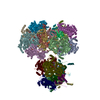
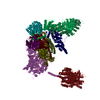
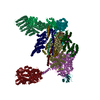
 PDBj
PDBj






































